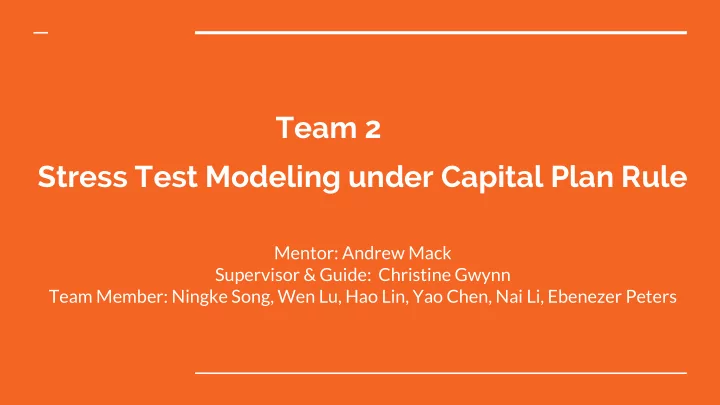

Team 2 Stress Test Modeling under Capital Plan Rule Mentor: Andrew Mack Supervisor & Guide: Christine Gwynn Team Member: Ningke Song, Wen Lu, Hao Lin, Yao Chen, Nai Li, Ebenezer Peters
Outline Overview of CCAR ● Project - Portfolio Description ● ● Methodology ● Discussion of Results & Conclusions in different scenarios Constraints & Limitation s ●
Overview of Comprehensive Capital Assessment Rule (CCAR) CCAR is the Federal Reserve framework for evaluating the risks of ● Banking and Financial Holding Entities. It provides guidelines for Stress Testing Under the risk exposures of Banking and Financial Entities under Three Scenarios: Baseline: Sustained, Moderated Economic Activity ○ Adverse: Global Weakening in Economic Activity ○ Severe: Substantial Weaken in Global Economic Activity, with a ○ large reduction in asset price Reference: http://www.federalreserve.gov/bankinforeg/ccar.htm
Project - Portfolio Description Fixed Income Assets ● US Treasury 5 year $ 1,000,000 ○ ● Equity Shares ○ Helix Energy Solutions #20000 AMC Entertainment Holdings #11000 ○ General Electric #16500 ○ ○ Apple #10000 ● Options AAPL170120P00100000 #100 ○ GOOG170120C00730000 #500 ○ ○ BA170120C00140000 #60
Methodology - Data Employed Quarterly Historical Stock Price (From Yahoo Finance) ● ○ Apple (From 1980) ○ AMC Entertainment (From 2013) General Electric (From 1962) ○ Helix Energy Solution (From 2011) e.t.c ○ ● Daily Historical Treasury Price (From U.S Department of the Treasury) ○ US Treasury for 3 month, 6 month, 1 year, 1.5 years, 2 years Historical volatility of different stocks (From Quandl) ●
Methodology Determine the contribution of historical shock variables on the driving ● factors of the asset prices and interest rate. Model selection for all portfolio assets ● determine which the shock variables provides strong prediction ○ fit and contributes to dependent variables. Reasonable qualitative and quantitative justifications needed. quantitative factors : t-statics, F-statics, p-values, AIC/BIC as ○ appropriate, R-sq etc.
Methodology Forecasting and Prediction of future values - 2016 to 2017 based on ● selected models for each asset using the scenarios described by : ○ Severely Adverse Market Shocks (Excel) ○ Adverse Market Shocks (Excel) ○ Macro Scenario Tables (Excel) ○ Supervisory Historical Data (Excel) as prescribed by the FEDs. GARCH Analysis for volatility regression ● Interest rate simulated by Vasicek model ● ● Calculation of VAR at 99% confidence for the stock price and interest rates under baseline, severe and adverse-severe scenarios to determine if the business has adequate capital and shocks to withstand demands of capital. ● Finally calculate total value our portfolio
Regression, Model Fitting & Selection for Google Before: GOOG stock price=-998.2+0.04476*Dow Jones Total Stock Market Index+38. 62*Unemployment Rate -14.09* 10-yr treasury yield +2.356*House Price Index+2. 583*Market Volatility Index-1.128*Real GDP growth Reasons: drop 10-yr treasury yield since low t statistic drop real GDP growth since it should be positive related. After: GOOG stock price =-972.4+0.04745*Dow Jones Total Stock Market Index+37. 28*Unemployment Rate+1.692*House Price Index+2.713*Market Volatility Index.
Vasicek model to simulate interest rate for Google Formula: r i +1=r i + α (t, r i )dt+ β (t,r i )*randn*sqrt(dt) ● ● Explanation ○ randn~normal distribution (0,1) the initial r i is the forecast r by regression model for 3 ○ month treasury rate. ○ α (t, r i ) and β (t,r i ) can be determined based on historical 3 month treasury rate
GARCH Model to forecast volatility for Google Formula: sigma t ^2=a+ ∑ b i R t-i ^2+ ∑ c j sigma t-j ^2 ● ● Explanation ○ Choose model among GARCH(1,1), GARCH(1,2), GARCH(2,1), GARCH(2,2) based on AIC
Monte Carlo to simulate stock price for Google Formula: S i+1 =S i *exp((r-sigma^2/2)*(dt)+sigma*sqrt(dt)*randn ● ● Explanation ○ randn~normal distribution (0,1) the initial S i is the forecast S by regression model for ○ Google ● VaR: take 99% quantile lowest in the stock simulation
Google Stock Prices VAR under 3 Scenarios
Discussion of Results & Conclusions Link to results: https://docs.google.com/spreadsheets/d/1ULIj96qNu3OJK- ● RkIpHhvGS4WKVLka0u7Lw8jo7Nukk/edit#gid=811678971 Discussion ● ○ The trend of total value of portfolio goes down by economy goes down Almost every stock price goes down. ○ ■ exception: AMC, since numbers of historical HV90 are limited. Value of fixed income goes down and up ○ ■ regression forecast of 0.5 , 1, 1.5, 2-yr treasury yield under severely adverse scenarios are relatively lower ● since the forecast data of 0.25,5,10 yr treasury yield from Federal Reserve are relatively lower under severely adverse scenario. ○ Related data of the portfolio provides good reference for banks to operate in weak or severely weak economic condition. ■ eg. how much capital to add in the portfolio. how to hedge the portfolio. how to manage their risk in different economic conditions
Constrains Regression model ● ○ regression then selection v.s. selection then regression ○ selection may not be perfect. limited numbers of historical data makes fitting and ○ forecasting vary ● Evaluation of portfolio ○ consideration the covariance between each asset
Questions
Recommend
More recommend